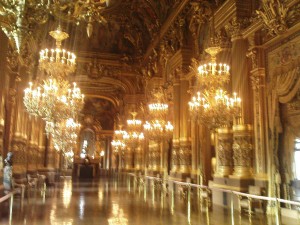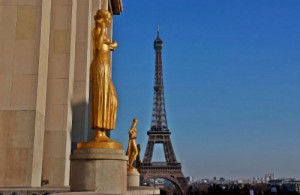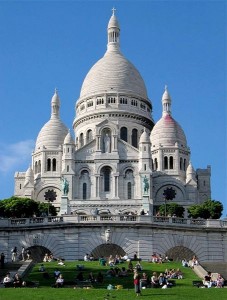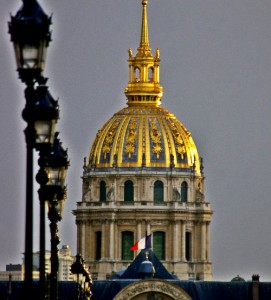It is early morning on 23rd June 1940.
Paris has been occupied for over a week. An armistice was signed in the same railway carriage, at the same spot in the Forest of Compiègne where Foch had imposed terms on the German delegation in 1918.
At Le Bourget the light catches a military transport aircraft landing. Hitler and his entourage (including Albert Speer, Hermann Giesler and Arno Breker, his favourite architects and sculptor respectively) are aboard, having flown from the Führer’s temporary HQ near Sedan.
The party had left at 3am, with the civilians in borrowed uniforms as Hitler would not permit civilians in his party on captured territory.
They drive through the awakening suburbs directly to the Paris Opera House, where they are met by Colonel Hans Spiedel of the Occupation Authority.
According to Speer’s account, Hitler is fascinated by the imposing building and inspects the opulent décor minutely, having studied the building plans.
Accompanied by a white-haired usher, the group moves through the deserted but brightly lit building, admiring the sweeping stairway, the foyer and the rest.
At the end of the visit Hitler instructs his adjutant to give the man a ‘pour boire’ (tip) – which is politely but firmly refused.
Twice.
The next items on the itinerary are the Madeleine, Place de la Concorde, and the Arc de Triomphe. At the Palais de Chaillot he poses with Speer and Breker, the Eiffel Tower looming behind them.
This is as close as Hitler gets to the Tower.
French officials have told the Germans that the lift cables have been cut!
The Führer declines to climb the stairs, allowing Parisians to the say that Hitler may have conquered France but he never conquered the Eiffel Tower.
At Les Invalides, Hitler stands contemplating the Napoleon’s Tomb, no doubt his eyes lingering on the names of the famous victories inscribed on the floor around the sarcophagus.
A cursory stop at the Panthéon (the proportions of which impress the Führer – unlike the Place des Vosges, Hôtel de Ville, and the Louvre) before a final stop at the Sacré-Coeur.
Standing with his entourage overlooking Paris he is recognised (and ignored) by those attending Mass.
By 9 am the tour is over.
But not before Hitler has ordered the destruction of memorials to General Charles Mangin and British nurse Edith Cavell, reminders of Germany’s First World War defeat.
He has already ordered the destruction of the armistice site and that the railway carriage used for the signature be exhibited in Berlin.
Hitler has spent three hours in the French capital.
During his visit Hitler talks of a victory parade in Paris. Discussing it with Spiedel, he decides against it, citing the possibility of harassment by the RAF.
Spiedel would later be involved in ‘Operation Valkyrie’, the plot to kill Hitler at the Wolf’s Lair near Rastenburg in Eastern Prussia.
In early December 1940 Hitler orders that the coffin of Napoleon II, the 21-year old King of Rome, be taken from its burial place in Vienna and returned to France.
Senior Wehrmacht officers accompany the heavy and imposing coffin as it is transported by special train to Paris.
On 14 December 1940, a century after Napoléon’s remains were returned to France from St Helena, ‘L’Aiglon’ joins his father under the dome at Les Invalides.
For the next quarter of a century the son is in the way. Committees meet to agree where put him. Nothing is decided – until De Gaulle decrees that he is reburied in the lower church, out
of the way, with only a small plaque to mark his final resting place.
It seems no one can bear to look at Hitler’s tainted gift.
(With thanks to one of my readers, Richard Maddox (UK), for his well written and exciting story of Hitler’s visit to Paris.)





Loved this post. Thanks, Richard Maddox. I did my History GCSE, A-Level and degree with a huge focus on the rise and fall of Hitler. All very interesting but it’s the stories like this that bring history to life.
Julia
Thanks Julia. To be able to step outside a history book into a real life situation makes things much more understandable.
Very informative post that really highlights the damage that Hitler did during such a short time while in Paris.
Thanks Laurel for your comments. Luckily however the damage to Paris was more emotional than physical! I’ll write about the threats to Paris another time!
Excellent post!! Really brought the history to life and full of details that were new to me.
Thanks Robin! Living under “occupation” must have been dreadful.
Great post John learned alot. Congratulations as well on the All Blacks Rugby win great for New Zealand
Lesley
Thanks Lesley for your comment. The rugby was such a relief for all the Kiwis, but the French were wonderful on the night too!
Agreed an excellent post. I specially appreciated this as many of my Jewish relatives suffered through Hitler’s visit to Paris.
Thanks Jill. You may have read in some of my earlier posts of the plaques around Paris highlighting where Jewish students and residents had been “taken” from their homes and sent away to the death camps. These sights still upset me when I walk around Paris.
I have read these with much interest. Yes these plaques are harrowing, but great that the French are acknowledging these facts.
Thanks John. I knew about the train, but not about all the rest of his visit. I also followed the link back on the carriage. Quite unique stories which I find more interesting than the usual travel article.
Thanks Jim for your comment. I also enjoyed the way the French told Hitler that the cables had been cut on the lift up the Eiffel Tower, so as to stop him going up it!! Brilliant!
Fascinating little story amid all the tales of battles and numbers of the dead. That little look at the pettiness of pride in destroying landmarks of the first German loss say a lot about war, nationalism and the rise of Hitler himself. (As does the idea of Aha, but he never conquered the Eiffel Tower)
Thanks for this interesting post John. I’d seen some footage of Hitler looking across to the Eiffel Tower but didn’t know anything else about his trip. Just 3 hours spent observing such an incredible city…what a shame (not that anyone wanted him there longer).
One thing I love so much about Paris is the chance to walk in the footsteps of so many great — or in this case the opposite of great — people. I was just at the opera house a few weeks ago and no idea I was walking up the same staircase as Hitler! Thanks again for an informative post on a subject we don’t hear a lot about.
Thanks Corey! But then when you were walking up the steps of the Opera House with Hitler a shadow beside you, there was the Phantom downstairs in the basement! Love it! “Walking in the footsteps of the great” – a good title for a book!
Wow, that’s a fascinating story! I had no idea about Hitler’s time in Paris but I really enjoyed that – with conflicted emotions of course. As evil as Hitler was, he was still a fascinating man to study, contemplate, and hate. I had no idea he had his own tour of Paris!
Thanks Jeremy. Would I have enjoyed being his tour guide that morning?? An interesting question – but yes I think it would have given me an opportunity to remind him how historical figures are “worshipped” or reviled, to remind him of wonderful historical figures who only helped people with equality, fairness and a feeling of “love”. MMmm – interesting thought!
Thank you for the very interesting history lesson in your excellent post. I had learned recently learned about Hitler at Sacré-Coeur, but not the rest of his short visit to Paris.
This is a very interesting history lesson. I especially liked the part about the Parisians cutting the lift cables of the Eiffel Tower so Hitler couldn’t “conquer” it.
Thanks Michael for your comment. There are some great stories about how the French fooled the Germans!
Oh the things I learn from you John…great post!
Love hearing about these fascinating tidbits of French history.
Keep ’em coming!
Cheers,
Priscilla